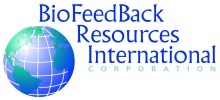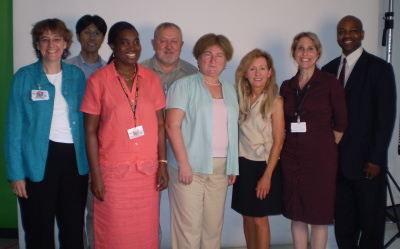

phone: 1-877-669-6463 ..... 914-762-4646






 |
 phone: 1-877-669-6463 ..... 914-762-4646 |






| |
A free email service that keeps you posted on new information
and products which increase the effectiveness of the services
you offer, the economic health of your practice, and your
creative thinking.
----------------------------------------------------------------
Inside this issue:
I. The Ideal Breathing Rate is Individual - by Harry Campbell
Dr. Paul Lehrer, Professor of Psychiatry at UMDNJ - Robert Wood Johnson
Medical School gave us a lesson on resonance frequency at the October 1, 2008
North East Regional Biofeedback Society (NRBS). Evgeny Vaschillo, Ph.D,
Associate Research Professor, Rutgers University, Bronya Vaschillo, MD,
Research Associate, Rutgers University, and Maria Karavidas, PsyD, Instructor
in Psychiatry, UMDNJ also presented with Dr. Lehrer on the subject of Heart
Rate Variability, resonance, and some of the applications for which they are
using HRV biofeedback, including depression.
Like many other people I have been learning and using heart rate variability
biofeedback in a fairly simplistic way. I continue to attend workshops on
heart rate variability to increase my understanding of this powerful
modality. Many people tend to use HRV because it is simple to apply the
sensor. The sensor is simply clipped to the finger or ear. There is no skin
prep, no cream or paste (unless you are using an EKG sensor), and no fussing
with the client's hair or even touching the client much. The process of skin
prep and applying sensors is a great deterrent to many clinicians who like
the idea of biofeedback but hesitate to use it. I still strongly suggest
that clinicians use all of the major modalities including EMG, Temperature,
Skin Conductance, Respiration, and EEG as well as HRV. There often is a best
modality to focus on for a specific purpose. A single modality usually will
not be the only one that should be used for most clients and most
applications. I have discussed this in other newsletters so I will not
address this further in this issue. Please refer to our archived newsletters
for more on this subject.
The idea of slowing the breathing to 6-10 breaths per minute is what most
people learn initially when we are taught respiration and HRV. Many of us
have been taught that 6 breaths per minute (BPM) is ideal. Dr. Lehrer
explained that 6 BPM is not ideal for everybody. He explained that each
person has a unique number of breaths per minute that is ideal for that
individual. He referred to this number of breaths per minute as the
resonance frequency. It is also sometimes called the resonant frequency.
Dr. Lehrer showed us a procedure that can be used to determine the resonance
frequency for a client/subject.
Breathing at the resonance frequency has a much greater positive health
effect than breathing at a rate even slightly slower or faster. It triggers
the barrow reflex. This causes the highest oscillations in the
cardiovascular system.
The procedure requires that you use a respiration pacer like the E-Z Air
(Available as a free down load from BFE (The Biofeedback Foundation of
Europe) web page. You can use this link to download the free pacer program:
E-Z Air is a software program that prompts a person to inhale and exhale at a
pre-determined rate. First you set the pacer at the number of breaths per
minute you want to test. It is suggested that you start at 6 breaths per
minute and work your way down to 4 BPM in .5 BPM steps. - 6.0, 5.5, 5.0, 4.5,
and 4.0. Have the client/subject practice breathing at the selected rate by
following the pacer for 2 minutes without recording HRV data. Start
recording HRV data once the client/subject is comfortable breathing at the
selected rate. Stop the recording after 2 minutes. Save the data. Let the
client/subject rest and breath normally for a few minutes.
Set the pacer to the next number of breaths per minute. Have the
client/subject practice breathing at that rate and repeat the process. Go
through this process for each breathing rate. You should now have HRV data
recorded for each breathing rate.
Inspect the spectral graphic report for each recording. Identify the highest
low frequency spectral peak. This should appear as a high amplitude peak
towards the left side of the graph somewhere around .1 Hz. It may be
slightly higher or lower than .1 Hz. There should not be other peaks
anywhere near the same amplitude as the highest peak for the breathing rate
that is the resonance frequency. You need to be able to quantify the
amplitude of the peak so that you can compare the different recordings at the
varied breathing rates. On the Heartmath Freeze Framer or EmWave-PC software
you should click on the View HRV Power Spectrum button. Look at the graph on
the bottom of the screen. The amplitude is represented in msec.²/Hz. Check
the amplitude for each data recording. The one that shows the highest
amplitude is the resonance frequency. This is the breathing rate that is
suggested for training for the individual client/subject.
The screen and amplitude units will be different on other software. Dr.
Lehrer has created a special application for HRV that works on the Procomp
Biograph Infiniti Software. You should now begin to train the client/subject
to breathe at the resonance frequency using a watch or clock with a second
hand or with the E-Z Air or other pacer. You should train them to do this in
the office and then have them practice it at home regularly. The
client/subject should practice reaching maximum HRV amplitude without the
breath pacer using only the HRV feedback by the third office session. The
office training process should be completed at the end of four sessions. The
client/subject should continue to practice at home regularly.
You should look up the writings of Paul Lehrer at University of Medicine and
Dentistry of New Jersey, Robert Wood Johnson Medical School for more detailed
information on this procedure.
EmWave-PC and Procomp Biograph Infiniti systems are available through
Biofeedback Resources International:
http://www.biofeedbackinternational.com/smart/emwavpc.htm
II. Announcements
NOTICE:
Register by December 31, 2008 to lock in current pricing.
Upcoming Training --------------
Biofeedback:
Neurofeedback:
Call 914-762-4646 or 877-669-6463 to schedule or go to our website:
Feel free to forward this newsletter to a friend.
****************************************************************


23 December 2008
- a BioFeedBack Resources International email newsletter -
written & edited by Harry L. Campbell, President
technical editing and production by Edwin Johnson
To subscribe or unsubscribe, please go to the end of this email.
----------------------------------------------------------------

(Evgeny Vaschillo, Ph.D. 4th from L, Bronya Vaschillo, M.D. 5th
from L,
Maria Karavidas, Psy.D. 7th from L, Harry L. Campbell 8th from L)
Picture taken at the Veterans Administration Medical Center, East Orange, NJ
http://www.biofeedbackinternational.com/smart/infinity.htm
http://www.biofeedbackinternational.com/smart/procmpph.htm
On January 1, 2009, training prices will increase as follows:
Biofeedback Current Price: $1,095 - New 2009 Price: $1,195
Neurofeedback Current Price: $790 - New 2009 Price: $995
Jan 24-28, 2009 - Miami, FL
May 2-6, 2009 - Hawthorne, NY
Aug 1-5, 2009 - Hawthorne, NY
Oct 24-28, 2009 - Hawthorne, NY
Apr 17-20, 2009 - Hawthorne, NY
Jul 17-20, 2009 - Hawthorne, NY
Nov 13-16, 2009 - Hawthorne, NY
http://www.biofeedbackinternational.com
If not subscribed, to continue receiving this newsletter, reply
to this email with the word, "subscribe" in the Subject.
----------------------------------------------------------------
To be removed from our newsletter email list, please reply to
this email with the word "remove" in the Subject.
----------------------------------------------------------------
Back issues are archived on our website.
Letters to the editor or comments: 
www.biofeedbackinternational.com
914.762.4646 877-669-6463
fax:914.762.2281
****************************************************************